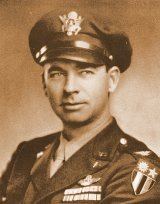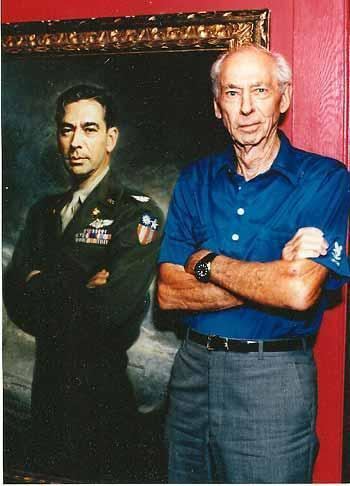Nickname(s) "Scotty" Name Robert Scott, | Years of service 1932–1957 Role Jr. | |
 | ||
Allegiance United States of America Commands held 23rd Fighter Group36th Fighter Bomber WingLuke Air Force Base Books God is My Co-pilot, Methods of Rhetorical Criticism, Flying Tiger: Chennault of China | ||
Book review of God Is My Co Pilot and The Day I Owned the Sky by Robert Lee Scott, Jr.
Robert Lee Scott Jr. (12 April 1908 – 27 February 2006) was a brigadier general in the United States Air Force. Scott is best known for his autobiography God is My Co-Pilot about his exploits in World War II with the Flying Tigers and the United States Army Air Forces in China and Burma. The book was eventually made into a film of the same name.
Contents
- Book review of God Is My Co Pilot and The Day I Owned the Sky by Robert Lee Scott Jr
- Early years
- Military career
- World War II
- Postwar
- Retirement
- Awards and honors
- Books written by Scott
- References

Early years

Scott was born in Waynesboro, near Macon, Georgia, the oldest of three children born to Ola and Robert Scott. As a youth, Scott was educated in Macon and became an Eagle Scout and recipient of the Distinguished Eagle Scout Award. At the age of five he witnessed the fatal aircraft crash of pioneer aviator Eugene Ely.
Military career

Upon graduation from the United States Military Academy at West Point in 1932, Scott completed pilot training at Kelly Field, Texas. In October 1933, he was assigned to Mitchel Field, New York. Scott flew air mail in 1934, commanded a pursuit squadron in Panama, and helped instruct other pilots at bases in Texas and California.
World War II

After World War II began, Scott joined Task Force Aquila in February 1942 to fly a group of Boeing B-17 Flying Fortress bombers to the China Burma India Theater. Anxious to join the mission, which was to bomb Japan from China, he professed to be an experienced B-17 pilot. He actually learned to fly it en route to Africa. Upon arrival in India, he found the mission had been scrubbed so he became stuck in India when he really wanted to be on the frontline in a cockpit flying combat. Within a month, he was executive and operations officer of the Assam-Burma-China (Ferry) Command, forerunner of the famous Air Transport Command, flying the Hump from India to China to supply the Kuomintang government. When the commanding officer left for China on 17 June, Scott was left in command of the operation for several days.

Still anxious to get into combat and wishing to learn the Flying Tigers' tactics, he obtained the use of a Republic P-43 Lancer, actually assigned to the Flying Tigers from Claire Chennault, with which he flew at least one high–altitude mission over Mount Everest, as described in the opening pages of his autobiography God Is My Co-Pilot. Scott began flying missions with the Flying Tigers, piloting a P-40 as a single ship escort for the transports and on ground attack missions. During this period, he frequently repainted the propeller spinner in different colors to create the illusion of a much larger fighter force in the area than a single aircraft, becoming in effect a "one-man air force".
In July 1942, at the request of Generalissimo Chiang Kai-shek, Scott was named commander of the 23rd Fighter Group, newly formed by General Claire Chennault when the Flying Tigers were incorporated into the USAAF. Popular accounts stated that Scott inherited command of the Flying Tigers, which was incorrect, since that "volunteer group" had disbanded at the conclusion of the pilots' contracts on 30 June. The 23rd later become part of the 14th Air Force.
Colonel Scott flew 388 combat missions in 925 hours from July 1942 to October 1943, shooting down 13 Japanese aircraft to become one of America's earliest flying aces of the war.
Scott was ordered back to the U.S. in October 1943 to become deputy for operations at the Army Air Force School of Applied Tactics at Orlando Army Air Base, Florida. He returned to China in 1944 to fly fighter aircraft equipped with experimental rockets directed against Japanese supply locomotives in eastern China. He then went to Okinawa to direct the same type of strikes against enemy shipping as the war ended.
Postwar
Scott then returned to the U.S. for staff duty in Washington, D.C. and other stations until 1947, when he was given command of the Jet Fighter School at Williams Air Force Base, Arizona. In 1951, he was reassigned to West Germany as commander of the 36th Fighter-Bomber Wing at Fürstenfeldbruck Air Base.
Scott graduated from the National War College in 1954 and was assigned to the Deputy Chief of Staff for Plans at Headquarters U.S. Air Force, and then to the position of Director of Information under the Secretary of the Air Force. In October 1956, he was assigned to Luke Air Force Base, Arizona, as base commander.
Retirement
Scott retired from the United States Air Force as a brigadier general on 30 September 1957, and remained in Arizona until the 1980s. He then lived in Warner Robins, Georgia, until his death in 2006. General Scott wrote about a dozen books including God Is My Copilot and The Day I Owned the Sky.
Scott continued to be active well into his retirement. In 1980, he gained national attention by hiking the length of the Great Wall of China. He had seen portions of the Wall during his 1944 flights near Peking, and by 1980 had managed to obtain Chinese government permission to make the 1,900 mile (3050 km) trek, which took 94 days. He carried his food (65 pounds of oatmeal cookies and nutrition supplements) on his back, slept on the ground adjacent to the wall, and obtained water (usually in the form of fruits) from houses along the way. He was never able to pay for the fruit, being told each time, "No, you are a guest of our country."
In 1984, he flew a General Dynamics F-16 Fighting Falcon jet fighter, and in 1995, a McDonnell Douglas F-15 Eagle. On his 89th birthday, in 1997, Scott flew in a B-1B Lancer bomber.
Awards and honors
For his combat record in World War II, Scott received two Silver Stars, three Distinguished Flying Crosses and three Air Medals.
During the 1996 Summer Olympics in Atlanta, Georgia, Scott carried the Olympic Flame along a section of Georgia State Route 247, which had been named in his honor.
